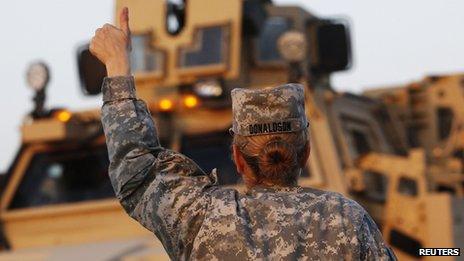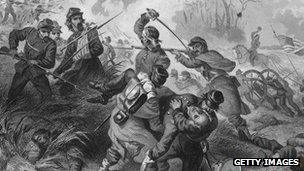Secret service: Woman who wore disguise to fight in war
- Published

Debate is raging in the US about an end to a ban on women serving in combat roles. But, 150 years ago, a Scotswoman living in America went to extraordinary lengths to fight on the frontline.
Last month, US Defence Secretary Leon Panetta lifted a ban barring women from ground-combat roles.
In the weeks since the historic announcement, arguments have been made for and against the ban's demise.
There has been debate over whether women are strong enough for combat roles, external and an argument that service in Afghanistan and Iraq has already placed women on the frontline, external.
But, in the past, women were willing to go to extraordinary lengths to see combat. They disguised as themselves as men and took new, masculine names before enlisting in the infantry.
Among them was Glasgow-born Marian McKenzie.
Shortly after her birth in 1844, her mother died and her father moved the family from Scotland to New York.
As a teenager, she pursued a career as an actress before giving up on that dream and travelling from town to town finding what work she could.
When the American Civil War broke out in 1861, she saw her chance of a great adventure, according to Larry Eggleston, author of the book Women in the Civil War.
Eighteen-year-old Marian cut her hair, dressed in men's clothing and joined the Union army's 23rd Kentucky Infantry Regiment as Pte Harry Fitzallen.
Eggleston said: "Harry Fitzallen is described in the military records as 5ft 3in tall, of Scottish origin, with a dark complexion, light blue eyes, black hair and coarse-looking and rounded features."

Women's motivation for entering war may have included employment and adventure
Four months after joining up, Marian's true identity was discovered. She was allowed to remain in the army as a nurse but left two months later to try again at serving as an infantryman.
From military records, Eggleston was able to track Marian over three years. She enlisted with various regiments - including the 92nd and 8th Ohio - and managed to last weeks or months before being found out and discharged before almost immediately enlisting with another unit.
She did not reach the frontline but did participate in long marches and garrison guard duties.
Eggleston said: "She only expressed adventure as her motive, but the fact that she served for three years and continually re-enlisted makes one believe that there were other, more patriotic motives involved in her decisions."
While researching his book, the writer also came across Kady Brownell, the daughter of a Scottish soldier who tried to serve as a combatant alongside her husband in the 1st Rhode Island Volunteers during the civil war.
Eggleston said: "She was sent back to Rhode Island by Colonel Ambrose E Burnside.
"However, Rhode Island governor William Sprauge intervened and she was returned to her husband's regiment, where she became a Daughter of the Regiment."
A Daughter of the Regiment, also known as vivandieres, were women attached to a unit and served in canteen duties.
Elizabeth Leonard, a professor of history at Colby College in Maine, said between 500 and 1,000 women were thought to have served as soldiers during the American Civil War.
She said: "We will never know for sure. Women soldiers did not want to be known and they often hid themselves very skilfully, sometimes not being discovered until very late in life."
Prof Leonard added: "I think that women's motivations for going undercover as male soldiers were diverse.
"Some surely enlisted so that they could stay close to men they cared about and, early on, this was probably the most common explanation that observers gave.
"But women also enlisted because they wanted to provide patriotic service and believed in the 'cause', be it Union or independence or slavery or abolition.
"They also enlisted for the sake of adventure: war offered the opportunity of travel and excitement that was inconceivable in regular life even for men - imagine how much more so for women."
Prof Leonard said other women, particularly those who needed to support themselves, had limited job opportunities in the 19th Century and soldiering offered an alternative to teaching and domestic service.
Several aspects of how armies operated in the civil war and the attitudes of the time may have helped women to maintain their double lives, the professor said.
Soldiers spent most of their time outdoors, allowing the women to keep a distance between themselves and men, something that would not have been possible in barracks.
The troops also rarely changed their clothes and a person in uniform was always assumed to be a man.
Prof Leonard added: "Historians today also think that it's quite possible that women who were passing as soldiers typically had at least one male member of their unit who actually knew their true identity and helped them to pass."